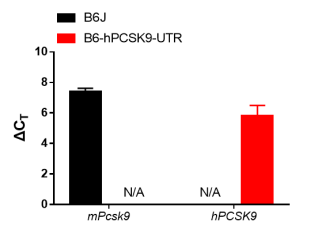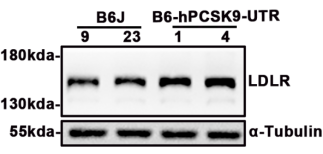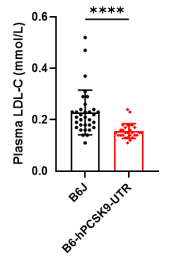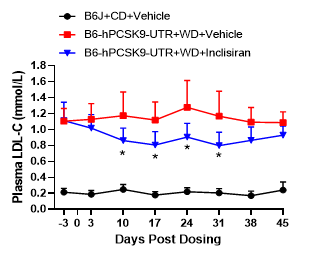PCSK9 is a secreted protein that is mostly found in liver tissue and known to inhibit LDLR expression in cell membranes. PCSK9 binds to LDLR and is degraded by lysosomes. Studies on the human PCSK9 gene have revealed that PCSK9 gain-of-function mutations are related to familial hyperlipidemia and that LDL-C levels in PCSK9 loss-of-function mutations are 15%–28% lower than in the general population. As a result, PCSK9 plays a key role in cholesterol metabolism. Inhibiting PCSK9 expression or activity can considerably lower "bad" LDL-C levels. As a result, PCSK9 is a promising target for anti-hyperlipidemic drug development.
GemPharmatech has developed the B6-hPCSK9-UTR mice which humanizes the entire coding region and 3' UTR of the mouse Pcsk9 gene. This strain is suitable for in vivo screening and evaluation of RNAi therapies that target hPCSK9, especially the 3' UTR of hPCSK9 mRNA.
Study Outline

Figure 1. Overview of pharmacodynamic studies on B6-hPCSK9-UTR mice.
Validation Data
1. hPCSK9 and mPcsk9 mRNA assay

Figure 2. In the livers of 5-week-old B6-hPCSK9-UTR mice, human PCSK9 mRNA is highly expressed, while no murine Pcsk9 mRNA was detected. Data are shown as Mean±SD, n=2.
2. hPCSK9 protein assay


Figure 3. Human PCSK9 protein expression was detected in the livers of 5-week-old B6-hPCSK9-UTR mice, but not in C57BL/6J mice.
3. Liver LDLR protein assay

Figure 4. LDLR protein expression was higher in the livers of 5-week-old B6-hPCSK9-UTR mice than in C57BL/6J mice.
4. Blood LDL-C level

Figure 5. LDL-C levels were slightly lower in the blood of 6-week-old B6-hPCSK9-UTR mice than in wild-type C57BL/6J mice. Data are shown as Mean±SD, n=28~33. ****, p<0.0001 by unpaired t test.
Efficacy Data
1. Efficacy evaluation of siRNA drugs in B6-hPCSK9-UTR mouse model

Figure 6. Inclisiran (3mpk) significantly lowered hPCSK9 levels in the blood of WD-fed B6-hPCSK9-UTR mice.

Figure 7. Inclisiran significantly lowered LDL-C levels in the blood of WD-fed B6-hPCSK9-UTR mice.

